An Upscaling–Downscaling Optimal Seamline Detection Algorithm for Very Large Remote Sensing Image Mosaicking
Abstract
:1. Introduction
2. Methodology
2.1. Pre-Processing
2.2. Obtain a Rough Seamline
2.2.1. Image Reduction
2.2.2. Establishing Network Flow
2.2.3. Graph Cut
2.3. Obtain the Pixel-Level Global Optimal Seamline
2.4. Image Color Blending
3. Experiments and Results
3.1. Experiment Scheme and Environment
3.2. Results
3.2.1. Big Data Remote Sensing Images
3.2.2. Ultra-Large Data Remote Sensing Images
4. Discussion
5. Conclusions
- (1)
- Our method is generally applicable to a wide range of remote sensing images, and the optimal seamlines can be automatically generated for remote sensing images with different relative locations and different feature information.
- (2)
- The idea of using reduced images is useful for very large remote sensing images, which may determine the feasibility of the algorithm; for other remote sensing images, our method’s computational efficiency is more advantageous than the other algorithms.
- (3)
- The proposed algorithm produces excellent results for both computational efficiency and color difference between the two sides of the seamline. It is better than the original methods using only graph cut or Dijkstra and the inclusion of super-pixels.
Author Contributions
Funding
Data Availability Statement
Conflicts of Interest
References
- Burt, P.J.; Adelson, E.H. A multiresolution spline with application to image mosaics. ACM Trans. Graph. 1983, 2, 217–236. [Google Scholar] [CrossRef]
- Kass, M.; Witkin, A.; Terzopoulos, D. Snakes: Active contour models. Int. J. Comput. Vis. 1988, 1, 321–331. [Google Scholar] [CrossRef]
- Williams, D.J.; Shah, M. A fast algorithm for active contours and curvature estimation. CVGIP Image Underst. 1992, 55, 14–26. [Google Scholar] [CrossRef]
- Li, X.; Hui, N.; Shen, H.; Fu, Y.; Zhang, L. A robust mosaicking procedure for high spatial resolution remote sensing images. ISPRS J. Photogramm. Remote Sens. 2015, 109, 108–125. [Google Scholar] [CrossRef]
- Pan, J.; Fang, Z.; Chen, S.; Ge, H.; Hu, F.; Wang, M. An improved seeded region growing-based seamline network generation method. Remote Sens. 2018, 10, 1065. [Google Scholar] [CrossRef] [Green Version]
- Yin, H.; Li, Y.; Shi, J.; Jiang, J.; Li, L.; Yao, J. Optimizing Local Alignment along the Seamline for Parallax-Tolerant Orthoimage Mosaicking. Remote Sens. 2022, 14, 3271. [Google Scholar] [CrossRef]
- Pan, J.; Wang, M.; Li, D.; Li, J. Automatic generation of seamline network using area Voronoi diagrams with overlap. IEEE Trans. Geosci. Remote Sens. 2009, 47, 1737–1744. [Google Scholar] [CrossRef]
- Pang, S.; Sun, M.; Hu, X.; Zhang, Z. SGM-based seamline determination for urban orthophoto mosaicking. ISPRS J. Photogramm. Remote Sens. 2016, 112, 1–12. [Google Scholar] [CrossRef]
- Pan, J.; Yuan, S.; Li, J.; Wu, B. Seamline optimization based on ground objects classes for orthoimage mosaicking. Remote Sens. Lett. 2017, 8, 280–289. [Google Scholar] [CrossRef]
- Zheng, M.; Xiong, X.; Zhu, J. A novel orthoimage mosaic method using a weighted A* algorithm–Implementation and evaluation. ISPRS J. Photogramm. Remote Sens. 2018, 138, 30–46. [Google Scholar] [CrossRef]
- Kerschner, M. Seamline detection in colour orthoimage mosaicking by use of twin snakes. ISPRS J. Photogramm. Remote Sens. 2001, 56, 53–64. [Google Scholar] [CrossRef]
- Dijkstra, E.W. A note on two problems in connexion with graphs. Numer. Math. 1959, 1.1, 269–271. [Google Scholar] [CrossRef] [Green Version]
- Chon, J.; Kim, H.; Lin, C.S. Seam-line determination for image mosaicking: A technique minimizing the maximum local mismatch and the global cost. ISPRS J. Photogramm. Remote Sens. 2010, 65, 86–92. [Google Scholar] [CrossRef]
- Ma, H.; Sun, J. Intelligent optimization of seam-line finding for orthophoto mosaicking with LiDAR point clouds. J. Zhejiang Univ. Sci. C 2011, 12, 417–429. [Google Scholar] [CrossRef]
- Hart, P.E.; Nilsson, N.J.; Raphael, B. A formal basis for the heuristic determination of minimum cost paths. IEEE Trans. Syst. Sci. Cybern. 1968, 4, 100–107. [Google Scholar] [CrossRef]
- Yu, L.; Holden, E.J.; Dentith, M.C.; Zhang, H. Towards the automatic selection of optimal seam line locations when merging optical remote-sensing images. Int. J. Remote Sens. 2012, 33, 1000–1014. [Google Scholar] [CrossRef]
- Zhang, J.; Sun, M.; Zhang, Z. Automated Seamline Detection for Orthophoto Mosaicking Based on Ant Colony Algorithm. Geomat. Inf. Sci. Wuhan Univ. 2009, 6, 675–678. (In Chinese) [Google Scholar]
- Ma, D.L.; Ding, N.; Cui, J. Optimizing ortho-image mosaic seamline based on Ant Colony algorithm. Sci. Surv. Mapp. 2013, 38. [Google Scholar]
- Wang, Q.; Zhou, G.; Song, R.; Xie, Y.; Luo, M.; Yue, T. Continuous space ant colony algorithm for automatic selection of orthophoto mosaic seamline network. ISPRS J. Photogramm. Remote Sens. 2022, 186, 201–217. [Google Scholar] [CrossRef]
- Soille, P. Morphological image compositing. IEEE Trans. Pattern Anal. Mach. Intell. 2006, 28, 673–683. [Google Scholar] [CrossRef]
- Pan, J.; Wang, M.; Li, J.; Yuan, S.; Hu, F. Region change rate-driven seamline determination method. ISPRS J. Photogramm. Remote Sens. 2015, 105, 141–154. [Google Scholar] [CrossRef]
- Li, L.; Yao, J.; Lu, X.; Tu, J.; Shan, J. Optimal seamline detection for multiple image mosaicking via graph cuts. ISPRS J. Photogramm. Remote Sens. 2016, 113, 1–16. [Google Scholar] [CrossRef]
- Li, L.; Tu, J.; Gong, Y.; Yao, J.; Li, J. Seamline network generation based on foreground segmentation for orthoimage mosaicking. ISPRS J. Photogramm. Remote Sens. 2019, 148, 41–53. [Google Scholar] [CrossRef]
- Yuan, Y.; Fang, F.; Zhang, G. Superpixel-based seamless image stitching for UAV images. IEEE Trans. Geosci. Remote Sens. 2020, 59, 1565–1576. [Google Scholar] [CrossRef]
- Yang, J.; Liu, L.; Yan, Q.; Deng, F. Efficient Seamline Network Generation for Large-Scale Orthoimage Mosaicking. IEEE Geosci. Remote Sens. Lett. 2022, 19, 1–5. [Google Scholar] [CrossRef]
- Chen, Q.; Sun, M.; Hu, X.; Zhang, Z. Automatic seamline network generation for urban orthophoto mosaicking with the use of a digital surface model. Remote Sens. 2014, 6, 12334–12359. [Google Scholar] [CrossRef] [Green Version]
- Zheng, M.; Xiong, X.; Zhu, J. Automatic seam-line determination for orthoimage mosaics using edge-tracking based on a DSM. Remote Sens. Lett. 2017, 8, 977–986. [Google Scholar] [CrossRef]
- Zhang, Y.; Zhang, M.; Du, S.; Zou, Z. Seamline optimisation for urban aerial ortho-image mosaicking using graph cuts. Photogramm. Rec. 2018, 33, 131–147. [Google Scholar] [CrossRef]
- Wan, Y.; Wang, D.; Xiao, J.; Lai, X.; Xu, J. Automatic determination of seamlines for aerial image mosaicking based on vector roads alone. ISPRS J. Photogramm. Remote Sens. 2013, 76, 1–10. [Google Scholar] [CrossRef]
- Wang, D.; Cao, W.; Xin, X.; Shao, Q.; Brolly, M.; Xiao, J.; Wan, Y.; Zhang, Y. Using vector building maps to aid in generating seams for low-attitude aerial orthoimage mosaicking: Advantages in avoiding the crossing of buildings. ISPRS J. Photogramm. Remote Sens. 2017, 125, 207–224. [Google Scholar] [CrossRef]
- Zheng, M.; Zhou, S.; Xiong, X.; Zhu, J. A novel orthoimage mosaic method using the weighted A* algorithm for UAV imagery. Comput. Geosci. 2017, 109, 238–246. [Google Scholar] [CrossRef]
- Boykov, Y.; Veksler, O.; Zabih, R. Fast approximate energy minimization via graph cuts. IEEE Trans. Pattern Anal. Mach. Intell. 2001, 23, 1222–1239. [Google Scholar] [CrossRef]
- Boykov, Y.; Kolmogorov, V. An experimental comparison of min-cut/max-flow algorithms for energy minimization in vision. IEEE Trans. Pattern Anal. Mach. Intell. 2004, 26, 1124–1137. [Google Scholar] [CrossRef] [PubMed] [Green Version]
- Adler-Golden, S.M.; Matthew, M.W.; Bernstein, L.S.; Levine, R.Y.; Berk, A.; Richtsmeier, S.C.; Acharya, P.K.; Anderson, G.P.; Felde, G.; Gardner, J.; et al. Atmospheric correction for shortwave spectral imagery based on MODTRAN4. Imaging Spectrom. V SPIE 1999, 3753, 61–69. [Google Scholar]
- Smith, P.R. Bilinear interpolation of digital images. Ultramicroscopy 1981, 6, 201–204. [Google Scholar] [CrossRef]
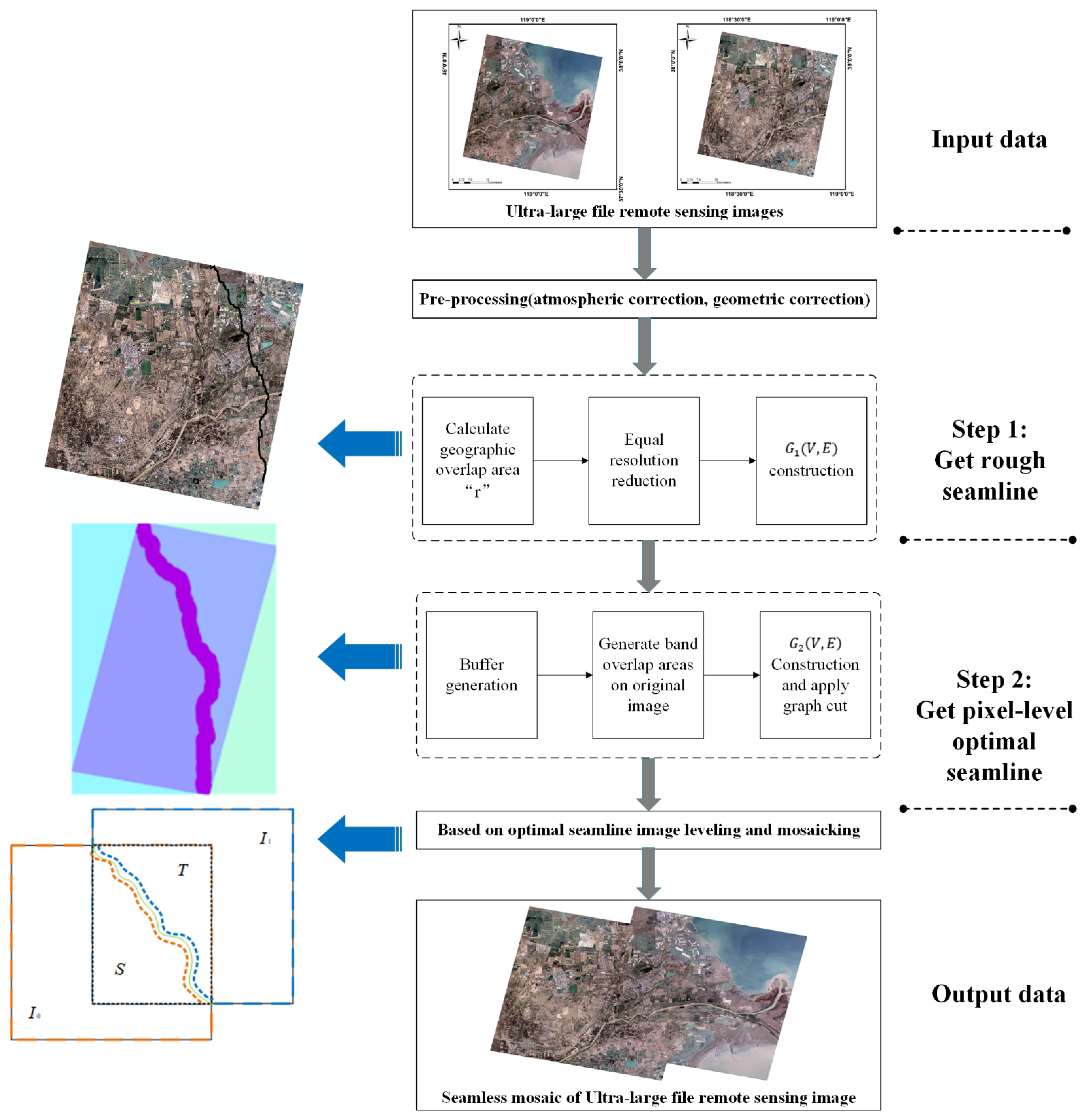



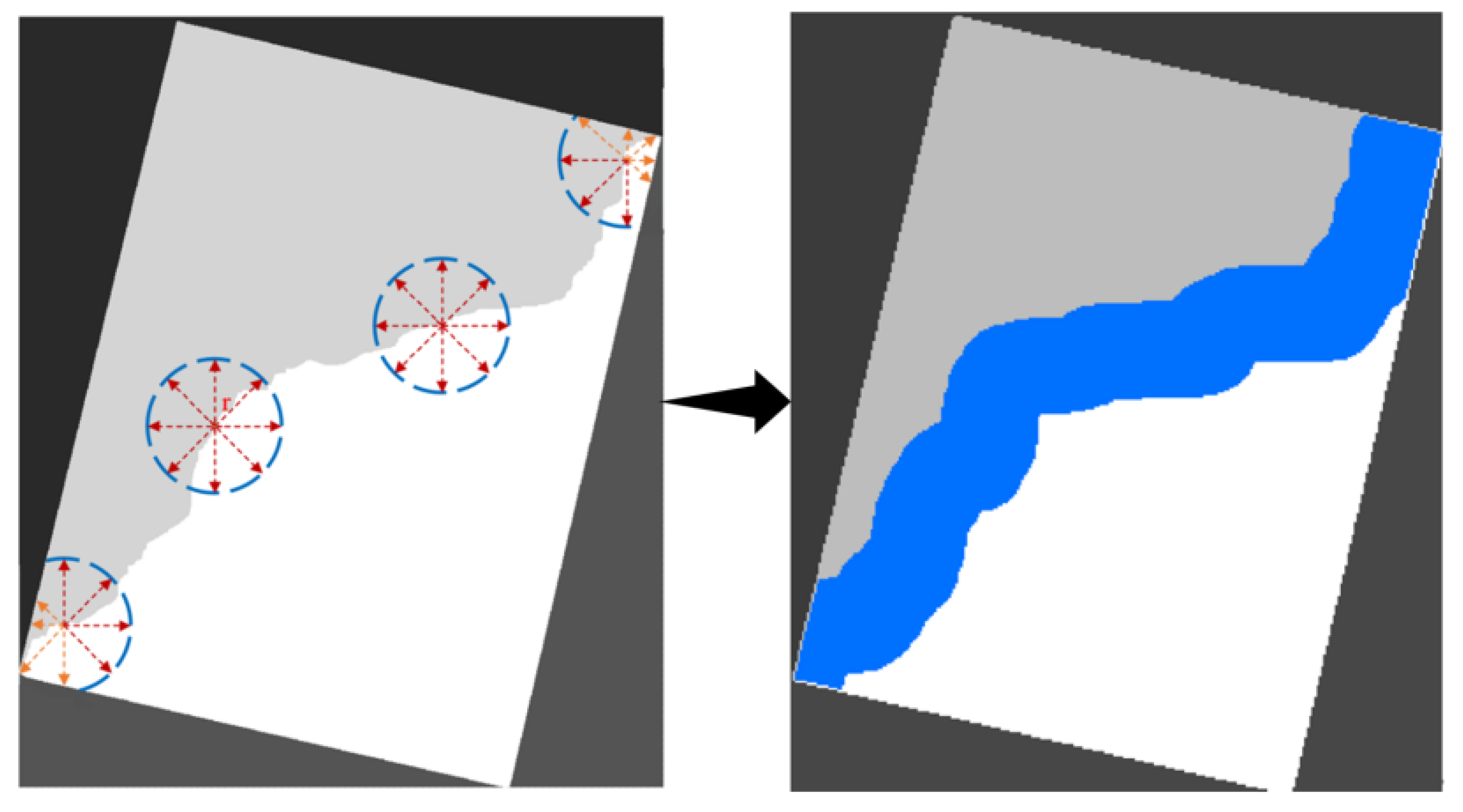
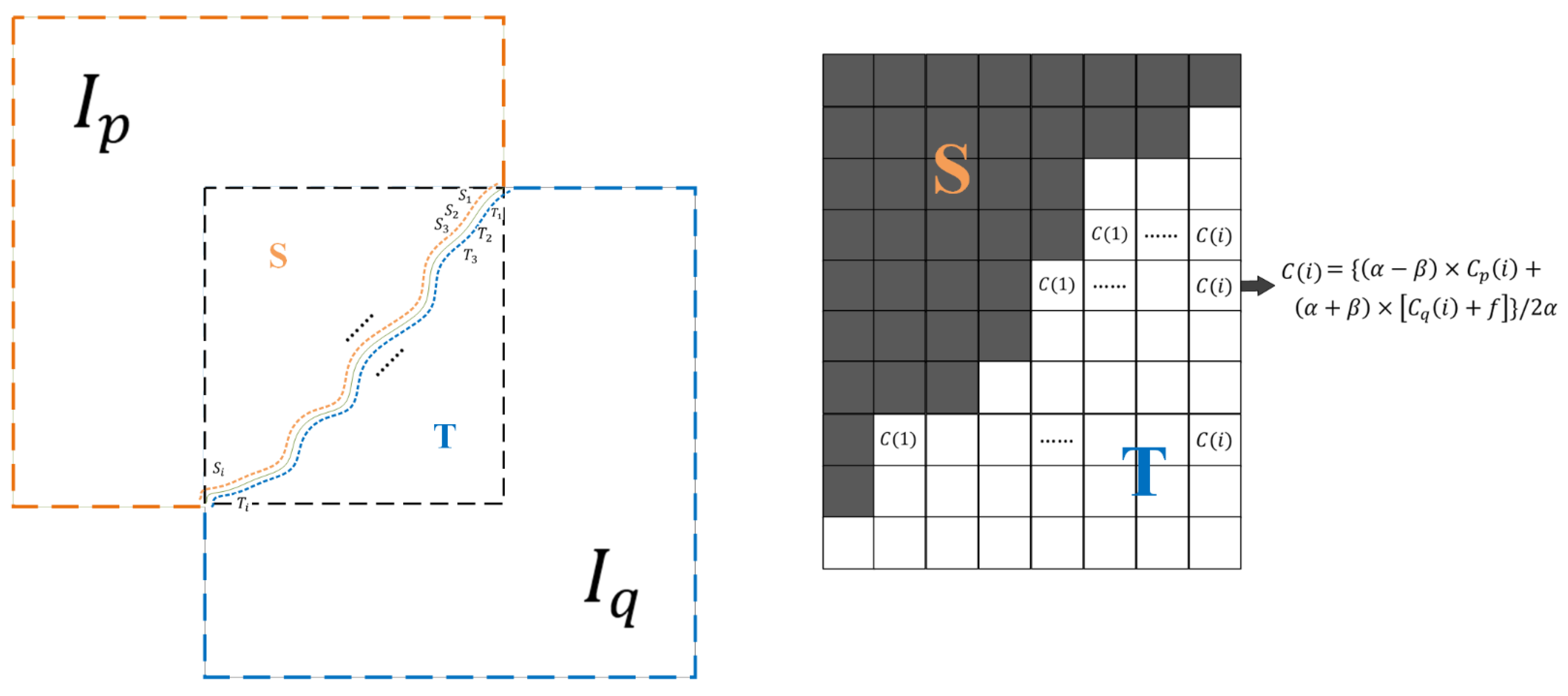
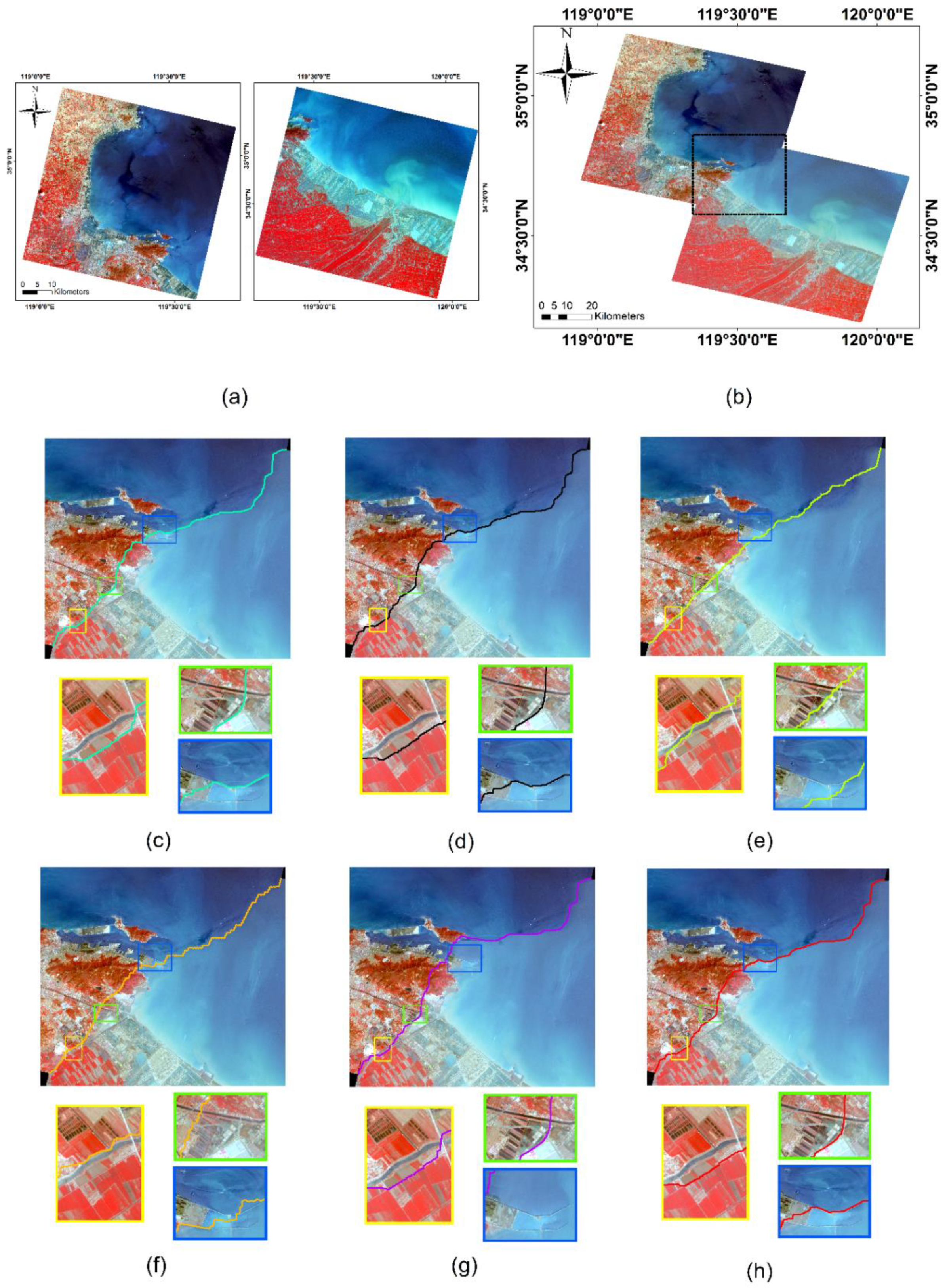

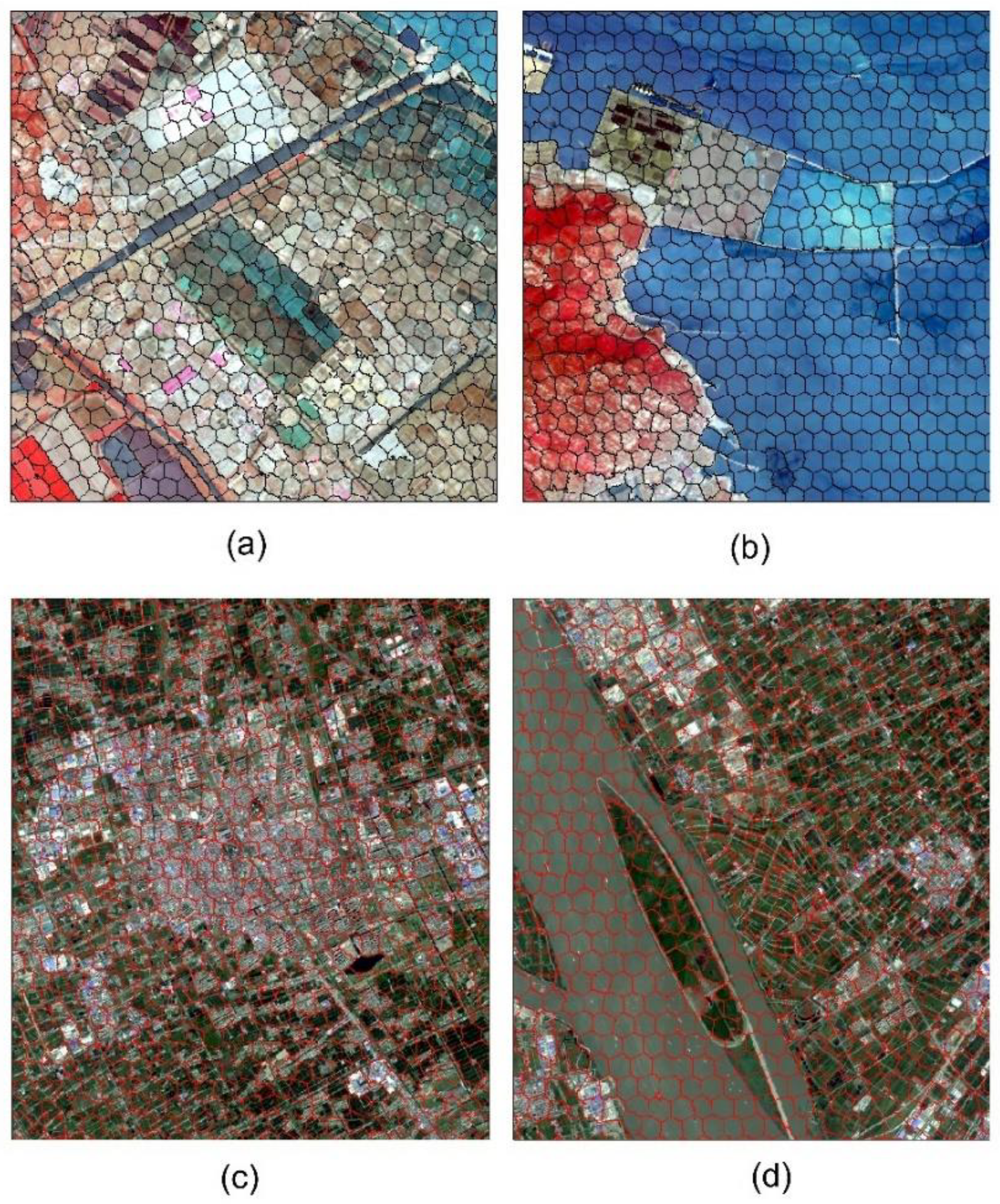
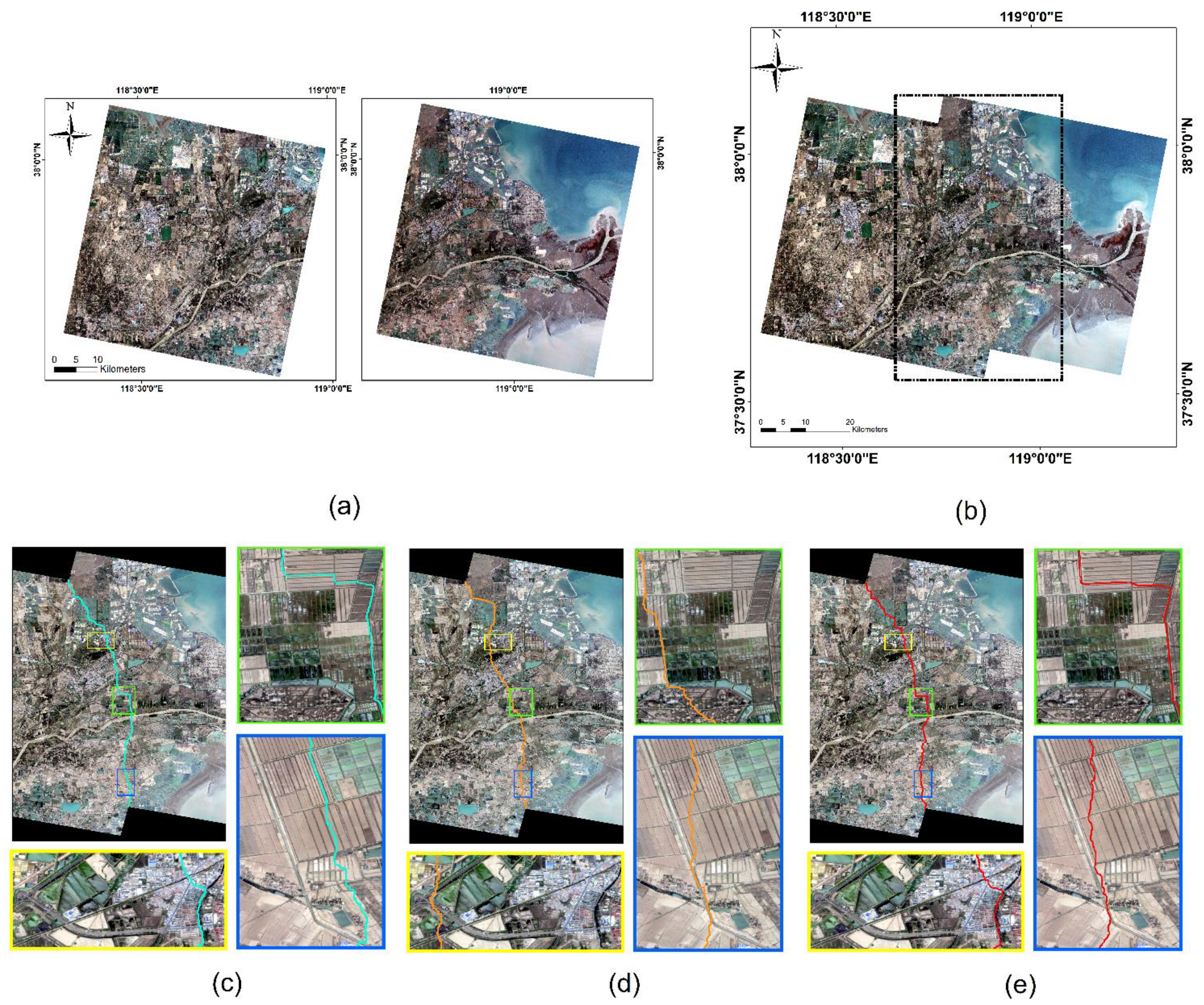
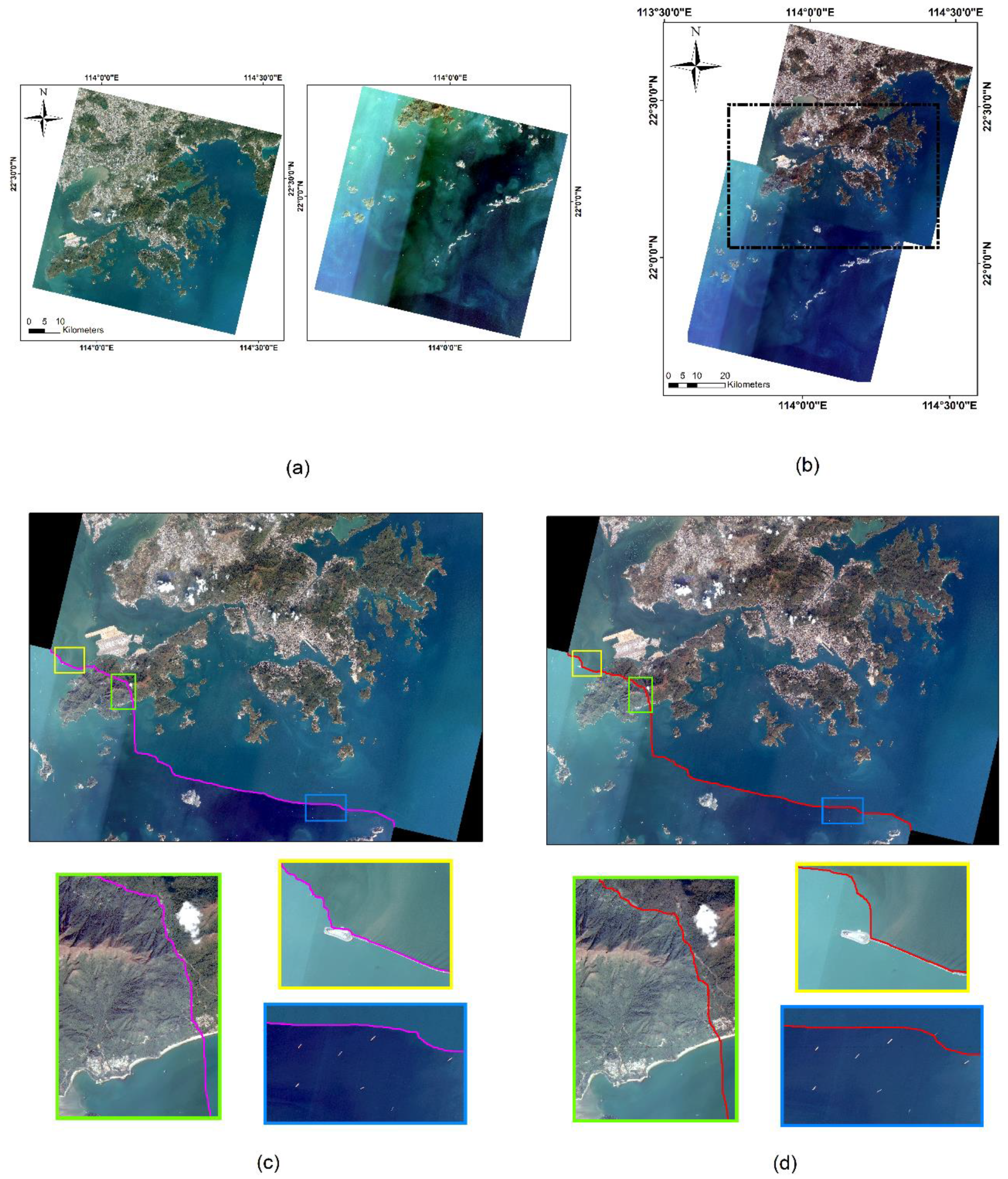
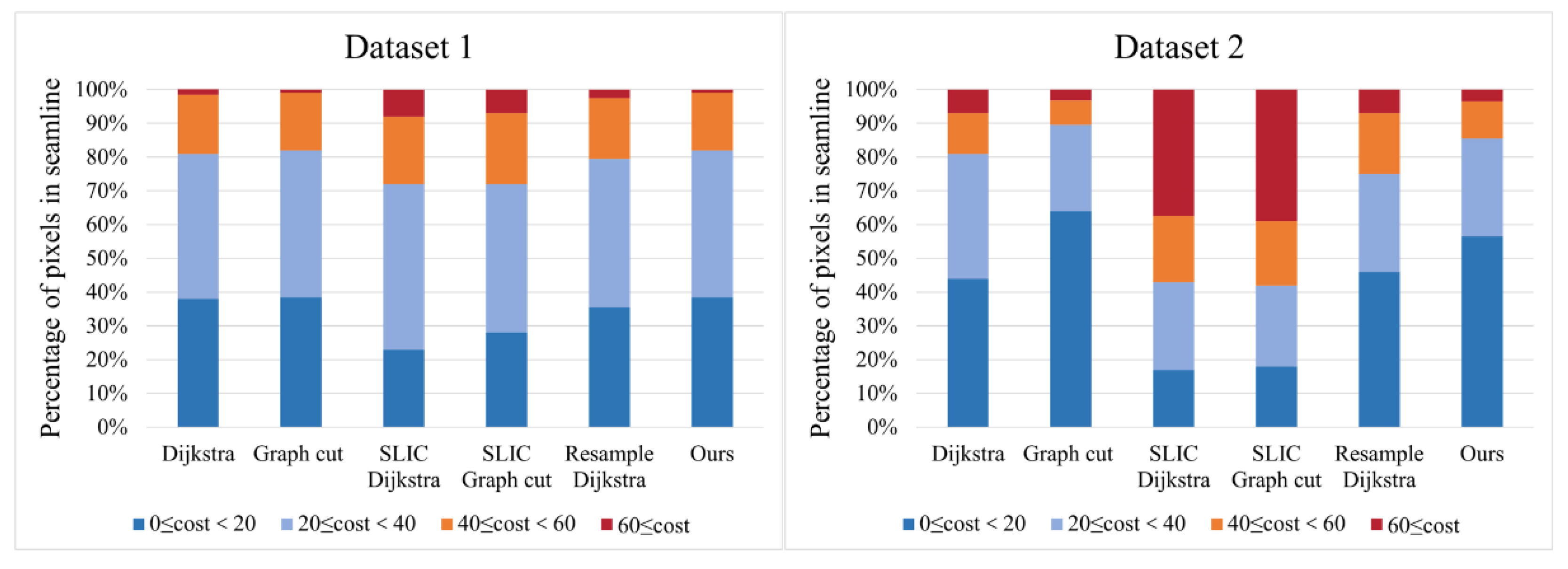
| Descriptions\Dataset | Dataset1 | Dataset2 | Dataset3 | Dataset4 |
|---|---|---|---|---|
| Image Location Type | Coastal zone | Cities | Farmland, plains | Islands, seas |
| Spatial Resolution | 30 m | 20 m | 6.8 m | 2.3 m |
| Image Size (pixel) | 7273 × 7227 | 5490 × 5490 | 11,309 × 9307 | 34,583 × 34,299 |
| Overlap Area Size (pixel) | 2752 × 3288 | 2279 × 5019 | 5668 × 7420 | 22,797 × 11,649 |
| Spectral Bands | R-G-B-NIR | R-G-B-NIR | R-G-B | R-G-B-NIR |
| Satellite | LandSat8 | Sentinel-2 | ZY-3 | GF-1 |
| Down-Sampling Factor | Running Time (s) | Number of Features Crossed | Average Color Difference | Refinement of the Color Difference Range Intervals | |||
|---|---|---|---|---|---|---|---|
| 0 ≤ Cost < 20 | 20 ≤ Cost < 40 | 40 ≤ Cost < 60 | 60 ≤ Cost | ||||
| 2 | 283.3 | 16 | 27.1 | 39.9% | 48.3% | 9.1% | 2.7% |
| 4 | 196.9 | 18 | 29.2 | 37.3% | 44.7% | 14.0% | 4.0% |
| 8 | 184.3 | 14 | 26.4 | 46.2% | 40.2% | 9.1% | 4.5% |
| 10 | 186.4 | 14 | 25.6 | 48.9% | 38.9% | 9.6% | 2.6% |
| 16 | 199.1 | 21 | 31.9 | 40.7% | 35.6% | 17.3% | 6.4% |
| 20 | 192.3 | 16 | 26.9 | 48.5% | 31.8% | 16.2% | 3.5% |
| Methods | Dijkstra | Graph Cut | SLIC Dijkstra | SLIC Graph Cut | Resample Dijkstra | Ours | |
|---|---|---|---|---|---|---|---|
| Dataset 1 | Average color difference | 26.1 | 25.6 | 29.2 | 34.5 | 26.2 | 25.6 |
| Number of features crossed | 16 | 14 | 13 | 11 | 17 | 14 | |
| Running time (s) | 470.7 | 428.4 | 2479.2 | 2358.2 | 210.6 | 186.4 | |
| Number of nodes | 6,174,101 | 6,174,101 | 515,774 | 515,774 | 1,485,686 | 1,630,815 | |
| Dataset 2 | Average color difference | 39.9 | 28.1 | 73.3 | 69.8 | 35.4 | 28.6 |
| Number of features crossed | 174 | 148 | 186 | 168 | 154 | 141 | |
| Running time (s) | 779.0 | 756.1 | 3908.3 | 3886.8 | 287.7 | 222.8 | |
| Number of nodes | 10,747,718 | 10,747,718 | 1,389,729 | 1,389,729 | 1,802,485 | 2,019,495 | |
| Dataset 3 | Average color difference | 7.91 | / | / | / | 8.02 | 6.40 |
| Number of features crossed | 97 | / | / | / | 73 | 64 | |
| Running time (s) | 3645.2 | >3 h | >3 h | >3 h | 524.9 | 459.5 | |
| Number of nodes | 27,047,738 | / | / | / | 3,310,807 | 3,730,547 | |
| Dataset 4 | Average color difference | / | / | / | / | 13.75 | 13.29 |
| Number of features crossed | / | / | / | / | 2 | 2 | |
| Running time (s) | >3 h | >3 h | >3 h | >3 h | 7241.9 | 5599.4 | |
| Number of nodes | / | / | / | / | 17,214,981 | 14,676,513 | |
| Algorithm | Advantage Comparison (Based on the Test Results, Divided into Excellent, Good and Poor) | |||
|---|---|---|---|---|
| Running Time | Average Color Difference | Number of Features Crossed | Ability to Handle Infinite Images | |
| Graph cut | good | excellent | good | No |
| Dijkstra | good | good | poor | No |
| SLIC Graph cut | poor | poor | excellent | No |
| SLIC Dijkstra | poor | poor | excellent | No |
| Resample Dijkstra | excellent | good | poor | Yes |
| Ours | excellent | excellent | good | Yes |
Disclaimer/Publisher’s Note: The statements, opinions and data contained in all publications are solely those of the individual author(s) and contributor(s) and not of MDPI and/or the editor(s). MDPI and/or the editor(s) disclaim responsibility for any injury to people or property resulting from any ideas, methods, instructions or products referred to in the content. |
© 2022 by the authors. Licensee MDPI, Basel, Switzerland. This article is an open access article distributed under the terms and conditions of the Creative Commons Attribution (CC BY) license (https://creativecommons.org/licenses/by/4.0/).
Share and Cite
Chai, X.; Chen, J.; Mao, Z.; Zhu, Q. An Upscaling–Downscaling Optimal Seamline Detection Algorithm for Very Large Remote Sensing Image Mosaicking. Remote Sens. 2023, 15, 89. https://doi.org/10.3390/rs15010089
Chai X, Chen J, Mao Z, Zhu Q. An Upscaling–Downscaling Optimal Seamline Detection Algorithm for Very Large Remote Sensing Image Mosaicking. Remote Sensing. 2023; 15(1):89. https://doi.org/10.3390/rs15010089
Chicago/Turabian StyleChai, Xuchao, Jianyu Chen, Zhihua Mao, and Qiankun Zhu. 2023. "An Upscaling–Downscaling Optimal Seamline Detection Algorithm for Very Large Remote Sensing Image Mosaicking" Remote Sensing 15, no. 1: 89. https://doi.org/10.3390/rs15010089
APA StyleChai, X., Chen, J., Mao, Z., & Zhu, Q. (2023). An Upscaling–Downscaling Optimal Seamline Detection Algorithm for Very Large Remote Sensing Image Mosaicking. Remote Sensing, 15(1), 89. https://doi.org/10.3390/rs15010089





